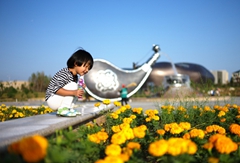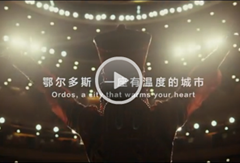Folk customs
Updated: 2017-06-08  Print
Print 



1. Ordos wedding
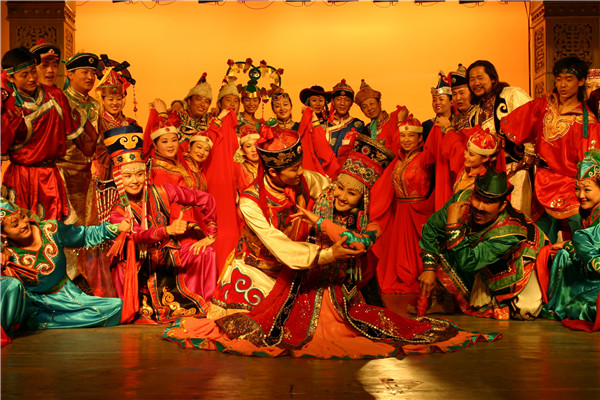
The wedding ceremony in Ordos has gained rich content and various forms over its long history, which has become a precious folk culture legacy. It was included as the first batch in the National Intangible Cultural Heritage list in 2006 by the State Council.
The completely preserved wedding ceremony that displays a mixture of Mongolian singing and dancing, expressing of good wishes, local customs, etiquette, costumes and food is a splendid, old, mysterious banquet with vivid features.
It embodies the unique nomadic, court and sacrificial cultures of Ordos, which is also a product of Mongolian folk culture.
A traditional wedding ceremony lasts a total of three days and two nights. The process includes a variety of rites, ranging from meeting the groom at the gate, offering gifts to the bride's family, marrying the bride with a bow, asking names and birth dates, toasting, sheep offering, receiving mother's blessing, baptizing with sacred water, unveiling the bride's veil, to offering tea to parents.
2. Memorial Rituals for Genghis Khan
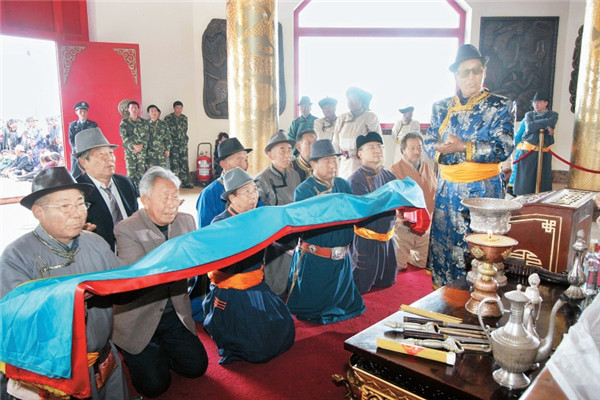
This is the highest form of Mongolian worship ceremony. This embodies the ancient Mongolian cultures and is a part of classic folk culture. The rituals were included as the first batch in the National Intangible Cultural Heritage list in 2006 by the State Council.
The rituals have a long history. When Genghis Khan died in 1227, the Mongol Empire built a portable mausoleum (a white yurt) to enshrine him as the "god of all Mongolians".
As relatives of Genghis Khan died, his portable mausoleums and relics gradually increased. Eventually, eight white yurts, or Eight White Palaces, became the primary mausoleums, led by the Mausoleum of Genghis Khan.
His grandson, Kublai Khan built a yellow palace for him in Shangdu (Xanadu), the capital of Yuan Dynasty (1206-1368) in 1264, and the Imperial Ancestral Temple in 1266 in Dadu, another capital, improving the sacrificial system. In 1282, Kublai Khan established several worship ceremonies and assigned officials that dealt with sacrificial affairs to write elegiac addresses, words and verses, which made worship rituals more complete.
In 1696,500 Dalhut households gathered to serve and guard the mausoleums, of which the rituals, for generations have increasingly been perfected and passed down to today.
The rituals preserved by them and Mongols are exactly what were practiced in the 13th century, which worship the Heaven, ancestors and heroes via ancient Mongolian rites of offering fire, milk, wine, livestock and songs.
A variety of precious sacrificial utensils with ethnic features are employed, which were made according to the prairie people's artistic sense of the nature and animals.
The rituals include sacrifice to Eight White Palaces, the black Sulde (the God of war) and the holy relics of the Khan.
Apart from daily worship, dozens of special rituals are held annually in unique forms. With rich content and a large scale, they reveal the old and mysterious traditional cultures.
The memorial rituals for Genghis Khan have constantly been improved over history and grown systematic, while being completed with distinct characteristics.
There are different types of mysterious, unsolved puzzles in these rituals, including the objects of worship, rites, forms, sacrifices, elegiac addresses and utensils. The methods that people use to pass on these rituals are absolutely unique and can't be found anywhere else on the entire world.
3. Chopsticks Dance
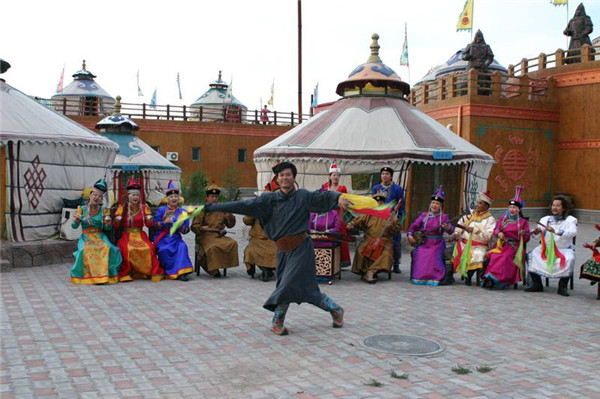
It got the name of "Chopsticks Dance" because dancers are known to knock chopsticks as an accompaniment. It is a folk dance for entertainment that is primarily popular in Otog Front Banner, Otog Banner, Uxin Banner and Ejin Horo Banner, Ordos.
In Ordos, at the climax of a wedding or celebration festival, people begin to dance with chopsticks, to folk music played on flute, sihu, sanxian, yangqin and Mongolian zheng. While shaking their bodies in different positions of kneeling, sitting or standing, dancers knock themselves on the hands, arms, shoulders, backs, waists, legs and feet, or sometimes the ground, with chopsticks in their right hand. The dancers are very passionate and swift to the lively rhythm.
Mongolians found out that chopsticks are very easy to drop during the dance, so they strung chopsticks in one end and decorated it with red silk, making them exquisite props that dancers can hold in one or both hands. These have enhanced the expression of the dance form and helped its growth.
People dressed solemnly dancing to a sprightly rhythm in swift moves, reveals the honesty, passion, courage and open mindedness of Mongols, while also showcasing their straightforward and wild nature. This is primarily the reason why the dance has strong ethnic features and high value in culture and arts.
4. Manhan folk song (Manhandiao)
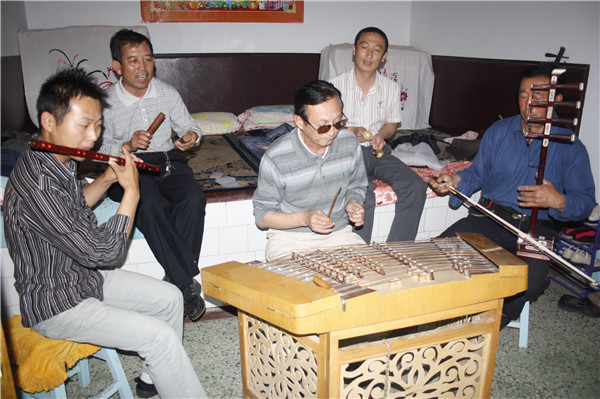
Manhandiao came into being about 200 years ago.
In the late Qing Dynasty (1636-1912), Han Chinese from Shanxi and Shaanxi swarmed into Zhunger Banner, Ordos. The Han and Mongolian people that lived together facilitated closer exchanges in not only life and production but in culture, and more importantly, in folk music.
In terms of melody, Manhandiao is primarily based on the short Mongolian song of Erdos, at the same time taking merits from the Mountain-climbing Song and the Song-and-dance Duet originating from Shanxi and Shaanxi.
In terms of lyrics, it falls into seven different types - recalling past sufferings, extolling, romance, eagerness, sadness, pain of parting and aspirations.
Its principal feature is that one song can be sung in several different tunes, while several songs might have the same exact tune.
Manhan songs belong to the genre of ditty and are performed accompanied by a three-musical-instrument band.
Compared with mountain songs, Manhandiao has absorbed more elements of art, while displaying a more fluent melody and stronger expression.
Manhandiao came out of ordinary people and simply mundane life. It has played an important role in advocating and enriching culture, in Zhunger's politics, economics, production and life in every period.
Today, it has spread rapidly outside of Zhunger to the western Inner Mongolia and the neighboring Shanxi and Shaanxi region and has occupied a place in China's ethnic folk music history.
5. Ordos Long Song - "Guru Songs"
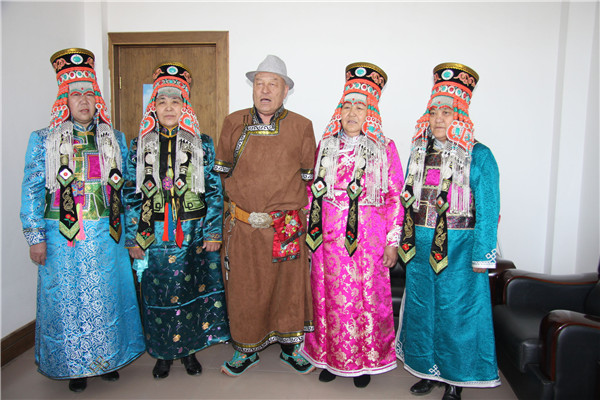
"Guru" in Mongolian means "national" or "governmental". The music originated in the court, spread among the people after the decline of the royal power, and became an ancient folk music genre.
These long songs are often sung unaccompanied by anything, themes of which are primarily blessing, praise and preach.
They have a beautiful and unique melody, a slow and free rhythm, and elegant styles, while indulging in serious topics and orthodox content, and sung with distinctive methods of singing.
These songs express the perception Mongols have towards life and their aspirations in the long development of their lives. These Mongolian court songs have been performed since the Yuan Dynasty (1206-1368), primarily during feasts, which are why they are known as a diamond of Mongolian classic music.
They are popular in a few regions along the river of Hanggin Banner.
Their main features are that the music is generally performed in a group of three songs at only grand ceremonies and not in any casual occasion. A chief singer - an old man or elder - sings first to begin the show, followed by three main songs in a chorus form.
The melody is slow but not sloppy and the rhythm is sometimes unclear with great turns and a natural chorus.
Unlike most Mongolian long and short music, the "Guru songs" are multi-voice, ethereal, desolate and solemn. Several masterpieces are "Holy Palace", "Heaven Horse" and "Tall Crops".
They are valuable not only for musicology, literature and linguistics, but are also an important reference for anthropology, ethnology and folklore.
For hundreds of years, the songs have been orally passed down among families and through mentoring relationships. Different regions and singers have nurtured a number of various styles.
6. Ordos Short Folk Songs
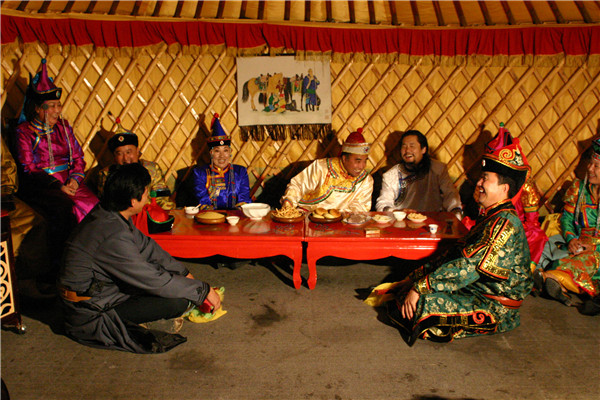
Ordos short folk songs are popular with local people due to its unique ethnic style and strong local features, while they have also taken in the common styles of Mongolian folk songs that are primarily in the mode of Yu.
They are mainly performed in Otog Front Banner, Otog Banner, Uxin Banner, Hanggin Banner, Ejin Horo Banner, Dalad Banner and Zhunger Banner, in Ordos.
The melody is novel and unique, bright and beautiful. Differing from long folk songs, short ones are short in structure, with neat sentences, powerful rhythm, cheerful mood, and vivid musical images. A short song generally has two lines - two or four sentences of rhyme, and a comparatively fixed beat. Lyrics are simple, but not rigid, and characterized by frequent use of reiterative locutions.
They are often impromptu thus very flexible. For example, it is very common to mix the different songs and even reverse the tones in one song.
Due to different geographical environment and customs, short folk songs have various modes but very few tune structures. They are simple, direct and neat thus very easy to be sung and popularized, and also easily blend in with the Ordos dance.
In addition, some of the songs are attached with words or short sentences in the end for balance or euphony, thus enriching their artistic expression.





 Ordos Impression
Ordos Impression Ordos WeChat
Ordos WeChat Ordos Reported
Ordos Reported

